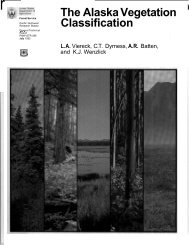Lectures on species interactions and competition
Lectures on species interactions and competition
Lectures on species interactions and competition
You also want an ePaper? Increase the reach of your titles
YUMPU automatically turns print PDFs into web optimized ePapers that Google loves.
Implicati<strong>on</strong>s of Resource-ratio hypothesis<br />
(Tilman 1988)<br />
Differences in the relative supply rates of limiting resources should<br />
lead to differences in the compositi<strong>on</strong> of plant communities:<br />
– Species allocati<strong>on</strong> patterns: Species with allocati<strong>on</strong> patterns focusing<br />
<strong>on</strong> shoots are assumed to be relatively effective competitors for light,<br />
<strong>and</strong> those allocating more heavily to roots are assumed to be good<br />
competitor for below-ground resources (water, nutrients).<br />
– L<strong>and</strong>scape implicati<strong>on</strong>s: Various habitats within l<strong>and</strong>scapes differ in<br />
their level of key resources, <strong>and</strong> hence will favor either root or shoot<br />
specialists depending <strong>on</strong> the local resource supply.<br />
– Successi<strong>on</strong> implicati<strong>on</strong>s: Resource supply ratios also vary<br />
systematically through successi<strong>on</strong>al series to first favor root<br />
specialists (because soil nutriti<strong>on</strong> is more limiting than light in primary<br />
successi<strong>on</strong>) <strong>and</strong> then shoot specialists because light is more limiting<br />
in later stages of successi<strong>on</strong>.
















